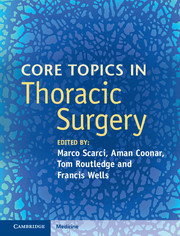Book contents
- Frontmatter
- Contents
- List of contributors
- Section I Diagnostic work-up of the thoracic surgery patient
- 1 Lung function assessment
- 2 Endobronchial and endoscopic ultrasound for mediastinal staging
- 3 Staging of lung cancer: mediastinoscopy and VATS
- 4 Access to the chest cavity: safeguards and pitfalls
- Section II Upper airway
- Section III Benign conditions of the lung
- Section IV Malignant conditions of the lung
- Section V Diseases of the pleura
- Section VI Diseases of the chest wall and diaphragm
- Section VII Disorders of the esophagus
- Section VIII Other topics
- Index
- References
3 - Staging of lung cancer: mediastinoscopy and VATS
from Section I - Diagnostic work-up of the thoracic surgery patient
Published online by Cambridge University Press: 05 September 2016
- Frontmatter
- Contents
- List of contributors
- Section I Diagnostic work-up of the thoracic surgery patient
- 1 Lung function assessment
- 2 Endobronchial and endoscopic ultrasound for mediastinal staging
- 3 Staging of lung cancer: mediastinoscopy and VATS
- 4 Access to the chest cavity: safeguards and pitfalls
- Section II Upper airway
- Section III Benign conditions of the lung
- Section IV Malignant conditions of the lung
- Section V Diseases of the pleura
- Section VI Diseases of the chest wall and diaphragm
- Section VII Disorders of the esophagus
- Section VIII Other topics
- Index
- References
Summary
Mediastinoscopy and lung cancer
Mediastinoscopy serves the purpose of providing tissue for the diagnosis of masses in the mediastinum. In addition, cervical mediastinoscopy is used to access the lymph nodes located in the middle mediastinum which represent the N compartment of the modern TNM staging for lung cancer. In addition, cervical mediastinoscopy represents a valid diagnostic tool for the diagnosis of lymphoma. Less frequently, it is possible to perform an extended mediastinoscopy by which the surgeon gains access to the lymph nodes of a specific area of the anterior mediastinum, namely, the pre- and subaortic ones beyond the reach of cervical mediastinoscopy. A safe and reliable performance of the procedure also in relatively inexperienced hands has been made possible by the implementation of video-assisted mediastinoscopy. As a result, tutoring of cervical mediastinoscopy has since become routine as well as recording of the procedure for medico-legal and training purposes. Video-assisted cervical mediastinoscopy for staging requires the patient to be under general anesthesia and the surgeon to perform the procedure according to time-honoured principles.
Surgical anatomy of video-assisted mediastinoscopy. A basic knowledge of the anatomy of the mediastinum is mandatory for the trainee approaching a surgical mediastinal exploration. The corridor where the mediastinoscope needs to be inserted is a parallelepiped. The posterior face of this geometric space is the anterior wall of the trachea, and it is first visualized when the mediastinoscope is first inserted in this corridor. The anterior wall of the trachea is indeed the pavement of this corridor and represents the landmark always to be kept in sight for orientation during the procedure. Laterally, the superior vena cava and the right paratracheal nodal stations are found. On the left side, lateral to the trachea, are the left carotid artery, the paratracheal nodal stations and the left recurrent nerve. Anteriorly, the innominate artery crosses this space as it emerges from the aortic arch towards the right thoracic inlet. At the carinal level, the pulmonary artery runs anteriorly, partially hidden by the subcarinal nodes. Laterally, on the right-hand side, the azygos vein is found as it encroaches the right main stem bronchus.
- Type
- Chapter
- Information
- Core Topics in Thoracic Surgery , pp. 17 - 24Publisher: Cambridge University PressPrint publication year: 2016



